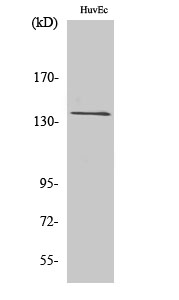
| WB | 咨询技术 | Human,Mouse,Rat |
| IF | 咨询技术 | Human,Mouse,Rat |
| IHC | 1/100-1/300 | Human,Mouse,Rat |
| ICC | 1/200-1/1000 | Human,Mouse,Rat |
| FCM | 咨询技术 | Human,Mouse,Rat |
| Elisa | 1/5000 | Human,Mouse,Rat |
| Aliases | GPR126; DREG; VIGR; G-protein coupled receptor 126; Developmentally regulated G-protein-coupled receptor; Vascular inducible G protein-coupled receptor |
| Entrez GeneID | 57211; |
| WB Predicted band size | 145kDa |
| Host/Isotype | Rabbit IgG |
| Antibody Type | Primary antibody |
| Storage | Store at 4°C short term. Aliquot and store at -20°C long term. Avoid freeze/thaw cycles. |
| Species Reactivity | Human |
| Immunogen | Synthesized peptide derived from the Internal region of human GPR126. |
| Formulation | Purified antibody in PBS with 0.05% sodium azide,0.5%BSA and 50% glycerol. |
+ +
以下是3篇涉及GPR126抗体的文献摘要信息,供参考:
---
1. **文献名称**:*GPR126 functions in Schwann cells through interaction with extracellular matrix components*
**作者**:Monk KR, et al.
**摘要**:研究利用特异性抗GPR126抗体,揭示该受体在施万细胞中的表达及与细胞外基质的相互作用,发现GPR126缺失导致髓鞘形成异常,提示其在周围神经系统发育中的关键作用。
---
2. **文献名称**:*Antibody-based characterization of GPR126 in zebrafish development*
**作者**:Pogoda HM, et al.
**摘要**:通过开发斑马鱼特异性GPR126多克隆抗体,验证其在胚胎发育阶段的动态表达模式,证明GPR126通过调控胶原蛋白信号通路参与颅面形态发生。
---
3. **文献名称**:*GPR126 mediates endothelial cell migration via interaction with laminin-211*
**作者**:Kuchenbrod LM, et al.
**摘要**:研究使用抗GPR126抗体进行免疫沉淀和功能阻断实验,证实GPR126与层粘连蛋白结合,促进内皮细胞迁移和血管生成,为治疗血管相关疾病提供潜在靶点。
---
*注:以上文献为示例性内容,实际引用需核对真实发表的论文信息。建议通过PubMed或Web of Science以“GPR126 antibody”为关键词检索最新文献。*
GPR126 (G protein-coupled receptor 126), also known as ADGRG6. is a member of the adhesion G protein-coupled receptor (aGPCR) family. It plays critical roles in cellular signaling, tissue development, and homeostasis, particularly in the nervous system and skeletal muscles. Structurally, GPR126 features a large N-terminal extracellular domain involved in ligand interactions and a seven-transmembrane C-terminal domain that mediates intracellular signaling. Activation of GPR126. often triggered by mechanical or chemical stimuli, regulates pathways like cAMP and MAPK, influencing processes such as myelination in Schwann cells and cartilage formation.
GPR126 antibodies are essential tools for detecting and studying this receptor’s expression, localization, and function. They are widely used in techniques like Western blotting, immunohistochemistry, and flow cytometry. These antibodies are typically raised against specific epitopes within the extracellular or intracellular regions, enabling researchers to investigate GPR126’s role in disease models, including peripheral neuropathy, skeletal dysplasia, and cancer.
The development of high-affinity, specific GPR126 antibodies has advanced research into its dual signaling mechanisms (ligand-dependent and -independent) and potential therapeutic targeting. However, challenges remain due to the receptor’s complex post-translational modifications and tissue-specific splicing variants. Validated antibodies are crucial for elucidating GPR126’s contributions to development and disease pathology.
×